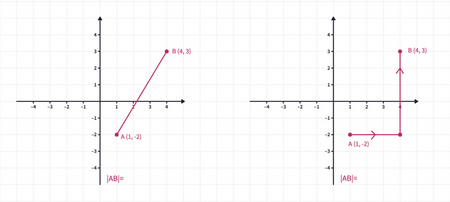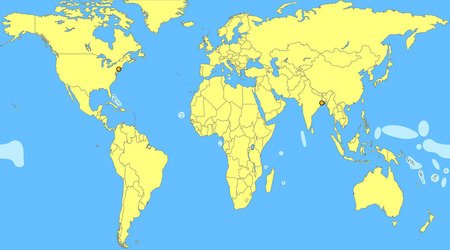
Some "Eurekas" of Mathematics - Part Ten
First published: Saturday December 30th, 2023
Report this blog
Introduction / Preliminaries
Thank you for taking the time to take a look at this blog! As the tenth installment of my mathematical series, I thought it would be nice to make it somewhat special, so I wanted to add some JetPunk spunk to it. Therefore I'm adding a bit of a geographical twist to it, while keeping the mathematical approach that I've tried to maintain throughout the series. And that's just where our topic lies! Somewhere in the realm of non-trivial mathematics, while dipping into geography, and dipping into geography in a manner that I believe JetPunkers would appreciate!
I want to begin by recalling some things from previous parts of the SEM blog series, primarily Part 2. This blog talks about hyperbolic, spherical, and Euclidean geometries. I will recall the last two. For more details than I provide in the next two paragraphs, read the blog that I hyperlinked above.
The sphere is most often the stock model for spherical geometry and the one we will be using in this blog. The defining axiom of spherical geometry (and so a sphere) is that parallel lines do not exist. You may be tempted to say that this isn't true since for instance the Tropics of Cancer and Capricorn are parallel. This is not the case as they are not geodesics, which we will delve into shortly.
The other geometry is Euclidean geometry, which is the one we're most familiar with. The defining axiom here is that given a line and a point (not on the line), there exists exactly one parallel line through that point. The go-to model is the Euclidean plane, which I'm certain we've all seen at some point.
Geodesics
The big term for this blogs: geodesics. So let's get started by looking at what we mean by this word and look at some of the most basic examples.
In layman terms, a geodesic can be thought of as the shortest path between two points. Wikipedia's definition is more precise and mathematical. It says that a geodesic is a curve representing in some sense the shortest path between two points in a surface, or more generally in a Riemannian manifold. When it says "in some sense," this means that the surface has some restrictions on it. In some cases, a more restrictive geodesic may be defined and/or can depend on the metric which is defined on that surface. However, typically the geodesics that you will see and think of are more intuitive: whatever surface you are on, the geodesics are what would appear as straight lines.
Geodesics on the Euclidean Plane
This is by far the most common geodesic, and as a matter of fact, everyone learns the formula for calculating geodesics on the Euclidean plane at a young age, whether they realize it or not. This is the distance formula! And the slogan is always "the shortest distance between two points is a straight line." But this isn't quite true since in the example we'll look at next, straight lines may not always appear straight.

So that means that if you want to get from point A to point B in as short of a distance as possible, then you must take the straight line that connects points A and B. See the left hand side of the figure below.
On the other hand, you can have other metrics in Euclidean space. These other metrics may define a new geodesic. One such simple example is the taxicab metric in which the distance between two points is the sum of the absolute values of the differences of the respective coordinates. In other words, the geodesics only travel vertically and horizontally. See below to see the difference between the two.

Geodesics on the Sphere
We now travel from the Euclidean plane onto the sphere, where we know from the preliminaries above that things don't quite work the same. In Euclidean space, geodesics were straight lines that go infinitely in both directions. Curved lines or segments where not actually geodesics. Similarly, in spherical space, we have a notion of geodesics. If you read all of the second installment of this blog series, mentioned in the introduction, you'll know that geodesics are great arcs. That is, an arc that follows along a circle which cuts the sphere into hemispheres. For instance, the equator cuts the globe into two equal halves (hemispheres), while the Arctic Circle does not cut the globe into equal halves, meaning that it is not a geodesic. The consequence of this is that the shortest distance between two points that both fall on the arctic circle would not follow the arctic circle.
This may be quite counter-intuitive, especially since we're so used to looking at a map which projects the globe (a 3D object) onto a page (a 2D object). To build some intuition, it's best to work some on your surface. So grab a globe and look at New York City and London. Use a piece of string to connect the two cities, and you'll see that this string indeed passes through Newfoundland, matching the image below.

Conclusion and "Quiz Question"
So the main conclusion that I wanted to draw is to relate this to airplane travel. Have you ever pulled up the real-time map on an airplane to see where exactly on the map you are and wondered "why are we flying way out here?!" Well a pilot is going to want to travel the shortest distance between his starting and ending location, meaning that his path will be a great arc!
To start, let's look at a real life example. I was recently talking to my friend who flew from his hometown (Kolkata) to New York City. He mentioned how he was flying over the south pole and, since we're both mathematicians, I'm sure you can imagine where the discussion went from there. So I figured I would pull up what his flight path would have been and we can see how this wouldn't match what we're probably so used to from our normal JetPunk map. Take a look at the image below and try to think of where the plane flew. What countries did he travel over? I'll give you a hint: he had simply misremembered and did not in fact fly over the south pole.

Now take a look at this link to see where his actual path was. How close were you?
So, there are two more general punchlines. The first is one that (in my opinion), you tend to hear a lot: map projections aren't perfect. I have seen much discussion over this topic on JetPunk over the years, and this certainly reaffirms that truth.
The other punchline is one that I think is more important: mathematics (and truth in general) may not always match what your intuition is telling you. Our intuition is a powerful thing! However, sometimes it isn't always properly aligned. This case of geodesics is certainly one example. Here is a list of some other truths that may seem counter-intuitive, some of which I have already discussed in past installments of this series (or may cover in future ones)!

And wow the RUB really seems to be coming back to life suddenly
And yes, I’ve noticed it too!
An uncle of me went to Toronto the previous month from Islamabad on a direct flight and he told me (seeing my interest in Geography) that he flied over Siberia, North Pole and Artic Ocean. I was much curious and didn't believed him but now I understand that he was true.
Thanks to this enlightening and informative series
I've also added the link to the Great Circle Map to my favourites list.
Anyway, loved reading it! I remember reading about this topic a couple of months ago when I got to know that the Air India flight connecting Delhi and San Francisco flies over Russia.
I did partially make sure to do this in time to prove Tatsu wrong.I hope to return to blogging this year... 🤞